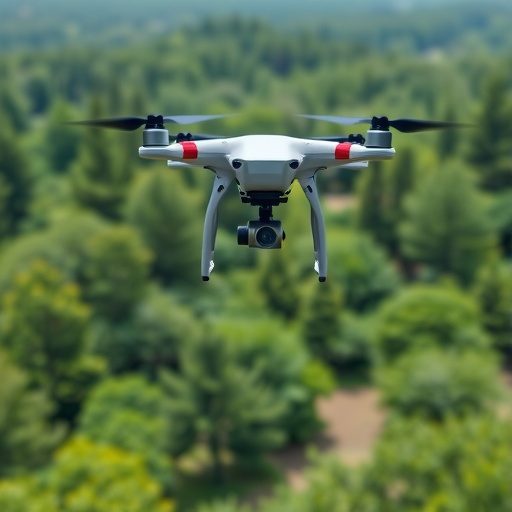A revolutionary innovation in the field of ecological research has emerged with the development of a new autonomous drone system known as WildWing. Researchers from The Ohio State University have designed this open-source unmanned aerial system (UAS) to enable ecologists to gather comprehensive insights into animal behavior in their natural habitats. Traditionally, the study of wildlife poses significant challenges, not least due to human interference which can drastically alter animal behavior and habitat usage. WildWing aims to mitigate these disruptions by providing an advanced, automated means of monitoring various species, particularly endangered ones.
One of the key advantages of WildWing lies in its ability to collect data quietly, a critical feature given that the presence of a human pilot can often deter wildlife from behaving naturally. In contrast to conventional methods of animal observation, which typically involve noisy human-operated drones, this new system can operate silently, allowing researchers to observe animals with minimal intrusion. As noted by Jenna Kline, the lead author of the study and a graduate student in computer science and engineering at Ohio State, the ability to harness remote sensing technologies like drones alongside artificial intelligence offers invaluable insights into the behavior of animals as their habitats undergo rapid changes due to climate and human activity.
At the heart of the WildWing system is a sophisticated computer vision model capable of autonomously identifying various animal species. Trained primarily on data collected from the Mpala Research Center in Kenya, the drone is designed to navigate autonomously through the terrain, continually adjusting its position to keep the target species centered within its view. This means that once an animal is detected, the drone can track it automatically, freeing researchers from the logistical burdens associated with piloting a drone while simultaneously conducting observational studies. This freedom enables scientists to focus on essential research objectives rather than getting bogged down by the technical aspects of drone operation.
The WildWing system already boasts impressive credentials. Having collected approximately 37,000 high-resolution images of endangered species, it stands as a monumental tool for standardizing data collection methods vital for behavioral analysis. The researchers conducted field tests at The Wilds conservation park in Ohio, focusing on tracking iconic African animals such as zebras and giraffes, alongside the reintroduced Przewalski’s horse. During these tests, the drone’s autonomous navigation performance was quantified and remarkably matched human tracking accuracy 87% of the time, highlighting the system’s reliability.
Moreover, the quality of the data yielded from the WildWing system is equally impressive. Nearly 100% of the frames captured were deemed usable, representing a significant leap forward when compared to traditional human-piloted drone operations. This high degree of data integrity is crucial for the development of computer vision models. By ensuring the data collected is both reliable and consistent, researchers can create datasets necessary for training algorithms to identify animal behaviors with unprecedented precision. The implications of this capability are profound, potentially leading to advancements in both ecological studies and artificial intelligence.
Co-author Tanya Berger-Wolf, who serves as the faculty director of Ohio State’s Translational Data Analytics Institute, emphasized that the adaptive nature of the WildWing system empowers scientists to overcome the existing limitations inherent in wildlife research. The potential applications extend beyond the immediate scope of animal behavior studies; they could also assist various fields that rely on extensive visual data, including imageomics, a burgeoning discipline focused on understanding biological processes through imagery. Researchers can study and analyze behaviors and environmental interactions with minimal impact, utilizing WildWing to enhance their scientific contributions.
Interestingly, the shift from traditional methods to this innovative solution reflects a broader movement toward the integration of commercial off-the-shelf technologies into research frameworks. Historically, generating tailored software for specific research applications has been prohibitively expensive. Yet, the establishment of WildWing as an open-source tool democratizes access to advanced research technologies, making sophisticated data collection capabilities available to a wider array of researchers and citizen scientists. The implications of this accessibility are vast, as it could inspire a new wave of ecological studies and facilitate greater collaboration in wildlife research at a global scale.
Looking ahead, the development team has ambitious plans for WildWing, intending to enhance its capabilities further by incorporating more complex datasets and extending its deployment into new environments. This initiative aims not only to validate the system’s versatility across different ecological contexts but also to ensure its utility in addressing more challenging questions pertaining to animal behavior and environmental interactions. By expanding the functionality of the WildWing system, researchers believe they can further unravel the intricate complexities of ecosystems and provide critical insights into the conservation of endangered species.
In essence, the advent of the WildWing drone system represents a paradigm shift in how scientists approach animal research. As Kline aptly stated, the infusion of technology allows researchers to piece together a more comprehensive understanding of our ecosystems in real time. The continuous exploration of technological capabilities in wildlife observation stands to revolutionize conservation efforts, facilitating an enhanced understanding of wildlife dynamics and behaviors. By maximizing the potential of modern drone technology within ecological research, the scientific community can leverage these advancements to protect biodiversity and promote responsible stewardship of our planet.
In summary, WildWing epitomizes the confluence of technology and ecology, birthing a new era for wildlife research. Researchers are propelled into a realm of enriched data collection and analysis, reshaping their ability to observe, understand, and ultimately preserve the natural world in an era where environmental challenges are more pressing than ever.
Subject of Research: Animals
Article Title: WildWing: An open-source, autonomous and affordable UAS for animal behaviour video monitoring
News Publication Date: 10-Mar-2025
Web References: http://dx.doi.org/10.1111/2041-210X.70018
References: Methods in Ecology and Evolution
Image Credits: Ohio State University
Keywords: Ecosystems, Animal research, Environmental methods, Animal science, Wildlife, Ecological modeling, Endangered species, Animal habitats.




